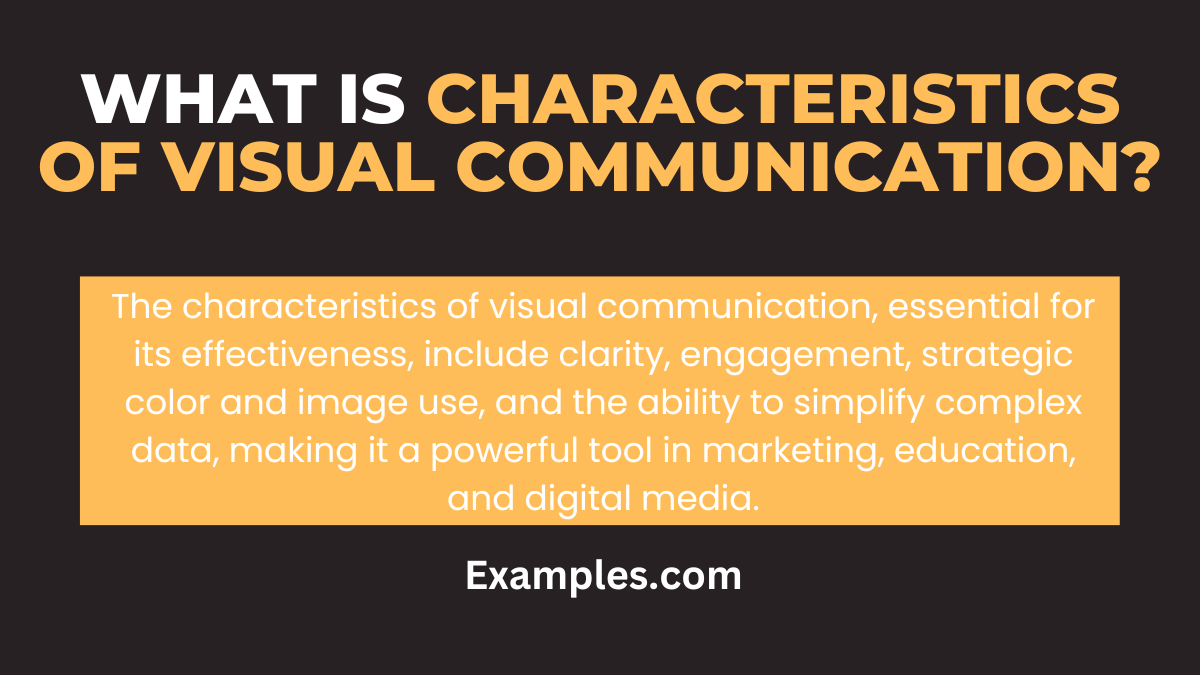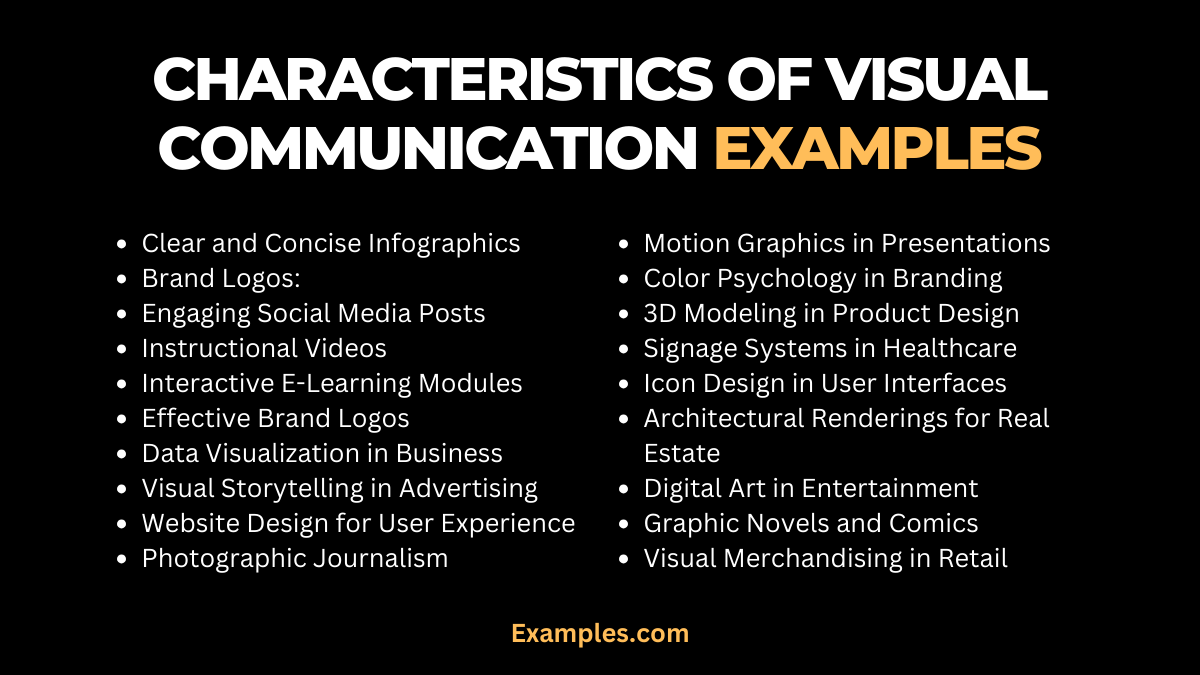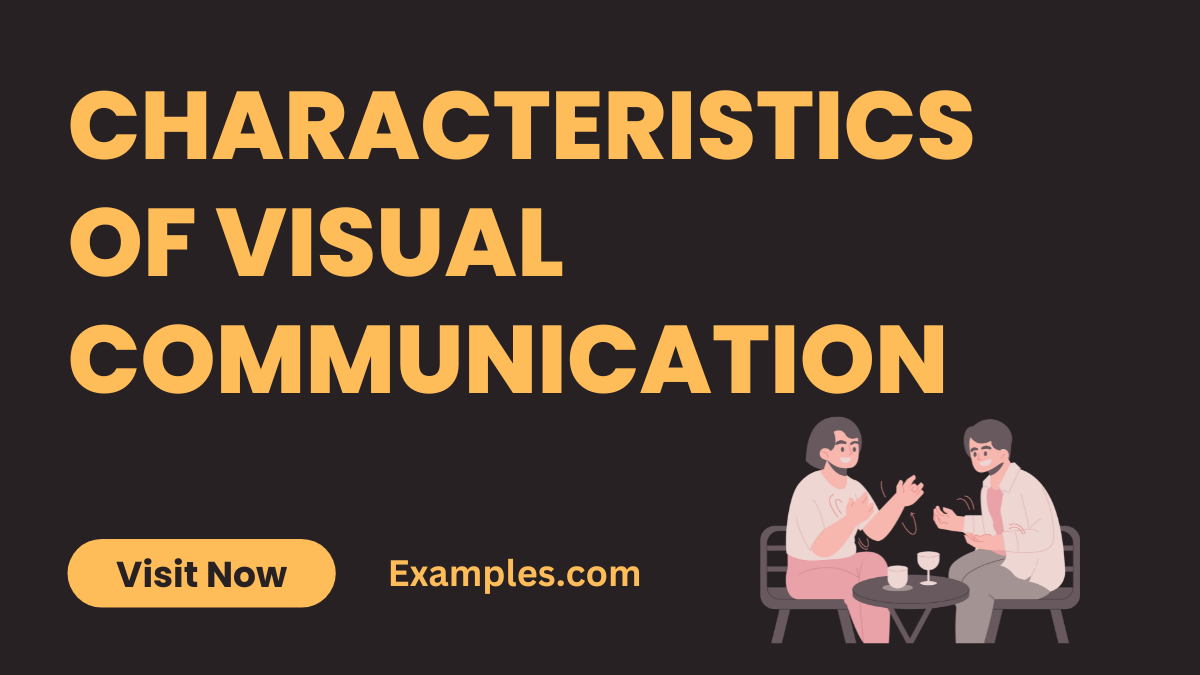19+ Characteristics of Visual Communication Examples
The “Characteristics of Visual Communication” guide offers a comprehensive exploration of the critical elements that make visual communication effective. It delves into various communication examples, illustrating how visuals like images, colors, and designs play a pivotal role in conveying messages effectively. This guide not only highlights essential features like clarity and engagement but also addresses the impact of these characteristics in different contexts, providing valuable insights for anyone looking to enhance their visual communication skills.
Download Characteristics of Visual Communication PDF
What is Characteristics of Visual Communication?

The characteristics of visual communication refer to the essential qualities that make visual media effective in conveying information. These include clarity, engagement, the strategic use of colors and images, and the ability to simplify complex data. These characteristics ensure that visual messages are easily understood, remembered, and impactful, making visual communication a powerful tool in various contexts like marketing, education, and digital media.
20 Characteristics of Visual Communication Examples

The realm of visual communication is vast, encompassing various characteristics that make it an effective tool for conveying information. It relies on elements such as clarity, visual appeal, and the ability to convey complex messages in an understandable way. These characteristics are essential in today’s visually-driven world, where the right use of images, colors, and design can significantly impact how information is received and interpreted. From marketing to educational materials, the effectiveness of visual communication is evident in its widespread application. Here are 10 distinct examples showcasing the diverse characteristics of visual communication:
- Clear and Concise Infographics: Distill complex data into easy-to-understand visuals.
- Example: An infographic explaining climate change statistics.
- Engaging Social Media Posts: Use compelling visuals to capture audience attention.
- Example: A visually striking post on a company’s new product launch.
- Instructional Videos: Simplify learning processes with visual aids.
- Example: A step-by-step tutorial video on software usage.
- Interactive E-Learning Modules: Combine visuals and interactivity for effective online learning.
- Example: An interactive e-learning course with engaging graphics and animations.
- Effective Brand Logos: Convey a brand’s identity through simple yet powerful imagery.
- Example: A logo design that encapsulates a brand’s ethos in a single image.
- Data Visualization in Business: Present complex business data in an accessible format.
- Example: A dashboard displaying sales trends with graphs and charts.
- Visual Storytelling in Advertising: Tell a brand’s story through compelling visuals.
- Example: An advertisement campaign using storytelling elements to connect with the audience.
- Website Design for User Experience: Enhance usability with intuitive visual design.
- Example: A website with a user-friendly layout and engaging visual elements.
- Photographic Journalism: Capture and convey news stories through powerful images.
- Example: A photojournalism piece that visually narrates a significant event.
- Environmental Graphics in Public Spaces: Provide information and direction through visual cues.
- Example: Wayfinding graphics in a large transportation hub.
- Motion Graphics in Presentations: Enhance presentations with dynamic and engaging visual elements.
- Example: A corporate presentation using animated graphs to highlight growth.
- Color Psychology in Branding: Utilize specific color schemes to evoke desired emotions in branding.
- Example: A brand choosing blue hues to convey trust and stability.
- 3D Modeling in Product Design: Visualize products realistically before they are manufactured.
- Example: A 3D model of a new gadget for investor presentations.
- Signage Systems in Healthcare: Use clear, understandable signs in hospitals for easy navigation.
- Example: Directional signs in a hospital to guide patients and visitors.
- Icon Design in User Interfaces: Simplify user interaction with intuitive icons in digital applications.
- Example: Custom icons in an app to improve user experience.
- Architectural Renderings for Real Estate: Showcase property designs before construction.
- Example: Virtual tours of planned residential complexes for buyers.
- Digital Art in Entertainment: Create visually appealing content for movies and video games.
- Example: Concept art for a video game’s fantasy world.
- Graphic Novels and Comics: Combine art and text for storytelling.
- Example: A graphic novel using unique illustrations to narrate a story.
- Visual Merchandising in Retail: Attract customers with creative product displays.
- Example: An eye-catching window display at a fashion retail store.
- Infographics in Public Awareness Campaigns: Spread important information through visually engaging infographics.
- Example: An infographic promoting environmental awareness.
Characteristics of Visual Communication for Business
In business, characteristics of visual communication involve leveraging visuals to simplify complex information, enhance brand identity, and improve client engagement. Effective visual communication in business ensures that messages are conveyed clearly, enhancing marketing efforts and internal communications.
- Business Dashboards: Visualize key performance indicators.
Example: Create a dashboard showing monthly sales trends. - Branding Elements: Communicate company values visually.
Example: Design a logo that reflects your company’s core values. - Marketing Collaterals: Use visuals in promotional materials.
Example: Develop brochures with engaging graphics and company colors. - Corporate Videos: Convey company stories.
Example: Produce a company culture video for recruitment purposes. - Presentation Design: Make business presentations impactful.
Example: Use visually appealing slides for investor presentations.
Characteristics of Visual Communication for Students
For students, the characteristics of visual communication include using visual aids to enhance learning, organizing information visually for better retention, and developing presentation skills. These characteristics aid in making education more engaging and effective.
- Educational Infographics: Simplify complex subjects.
Example: Create an infographic on a historical event. - Mind Mapping: Organize thoughts visually.
Example: Use a mind map for biology topics. - Digital Portfolios: Display work creatively.
Example: Assemble a digital portfolio of art projects. - Visual Note-taking: Enhance lecture comprehension.
Example: Incorporate visuals into class notes for better recall. - Group Presentations: Use visuals for team projects.
Example: Collaborate on a visually driven group presentation.
Characteristics of Visual Communication at Work
At the workplace, the characteristics of visual communication involve using visuals to streamline communication, enhance understanding, and promote efficiency. Visual aids are used for presentations, training, and conveying information effectively to team members.
- Team Meeting Graphics: Clarify points in meetings.
Example: Use a graph to explain quarterly goals. - Training Videos: Simplify complex processes.
Example: Develop training videos with step-by-step visuals. - Internal Communication Posters: Share information visually.
Example: Create posters for workplace safety guidelines. - Client Proposals: Enhance proposals with visuals.
Example: Include charts and infographics in business proposals. - Email Newsletters: Engage employees with visuals.
Example: Design an internal newsletter with engaging graphics and layouts.
What are the characteristics of a good visual in communication?
Good visuals in communication are essential for effectively conveying information and engaging the audience. The characteristics of a good visual include:
- Clarity: The visual should convey the message clearly and be easily understood.
- Relevance: It must be relevant to the topic or message being communicated.
- Simplicity: Avoid overcomplicating the visual with unnecessary elements.
- Consistency: Maintain a consistent style and color scheme.
- Attention-Grabbing: The visual should be designed to capture and hold the audience’s attention.
- Emotionally Engaging: Use visuals that can evoke an emotional response.
- Cultural Appropriateness: Be mindful of cultural sensitivities and diversities.
- Accessibility: Ensure the visual is accessible to people with disabilities.
- Aesthetic Appeal: It should be visually appealing and professionally presented.
- Purposeful: Every element of the visual should serve a purpose in the communication.
What are the Principles of Visual Communication?
Visual communication is governed by several principles essential for creating effective and engaging visuals. These principles ensure that visual messages are conveyed clearly and effectively:
- Clarity and Simplicity: Keep visuals clear and straightforward.
- Consistency: Maintain a uniform style and color scheme.
- Emphasis: Highlight key information visually.
- Balance and Alignment: Ensure visual elements are well-balanced and aligned.
- Contrast: Use contrasting colors for better visibility.
- Relevance: Ensure all visuals are relevant to the message.
- Audience Understanding: Tailor visuals to the audience’s preferences and understanding level.
- Color Usage: Apply color psychology effectively.
- Typography: Choose readable and appropriate fonts.
- Feedback and Adaptation: Continuously seek feedback and adapt visuals accordingly.
Tips for Effective Visual Communication
To enhance the effectiveness of visual communication:
- Understand Your Message: Clearly define the message you want to convey.
- Know Your Audience: Tailor your visuals to the audience’s needs and cultural context.
- Use High-Quality Images: Opt for clear, high-resolution images.
- Incorporate Data Visualization: Use charts and graphs for complex data.
- Leverage Branding Elements: Include consistent branding for recognition.
- Keep It Organized: Arrange visual elements in a logical order.
- Utilize White Space: Avoid clutter by using white space effectively.
- Engage Emotionally: Use visuals that evoke emotional responses.
- Stay Updated: Keep abreast of the latest trends in visual design.
- Practice and Experiment: Continuously refine your visual communication skills.
What is the Core of Visual Communication?
The core of visual communication lies in conveying messages effectively through visuals like images, charts, and videos, enhancing understanding and engagement.
Why are Signs Important in Visual Communication?
Signs are vital in visual communication as they provide quick, universally understandable information, crucial for navigation and safety.
What is the Main Objective of Visual Communication?
The main objective of visual communication is to effectively convey information and ideas, ensuring clarity and improved audience comprehension.
To conclude the article on “Characteristics of Visual Communication” on Examples.com, consider adding the following paragraphs:
In summary, the characteristics of visual communication shape how effectively we convey and interpret messages visually. From marketing campaigns to educational materials, understanding these characteristics can significantly enhance the impact of visual messages. For more in-depth exploration, the National Science Foundation provides valuable insights on the psychometric characteristics of visual communication.
Additionally, the Warbleton Council offers a broader perspective on visual communication’s role in various fields. These resources further illuminate the nuances of visual communication, making them valuable for anyone looking to deepen their understanding of this field.



